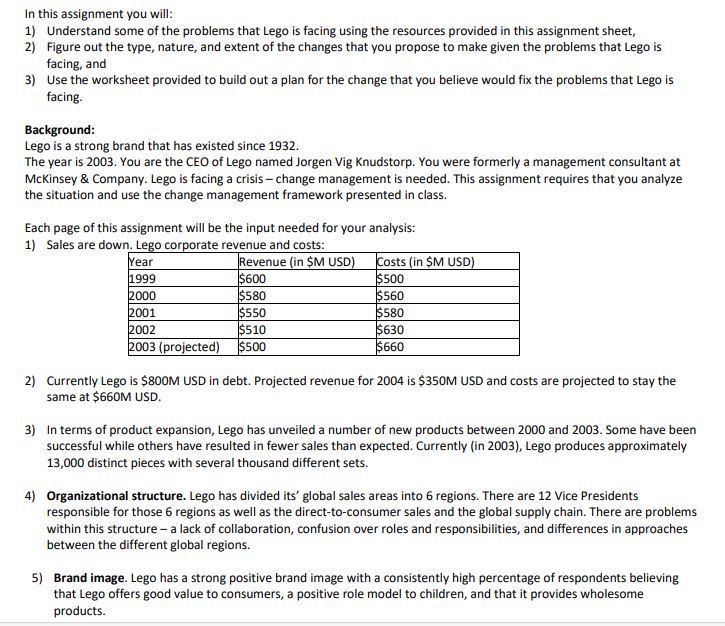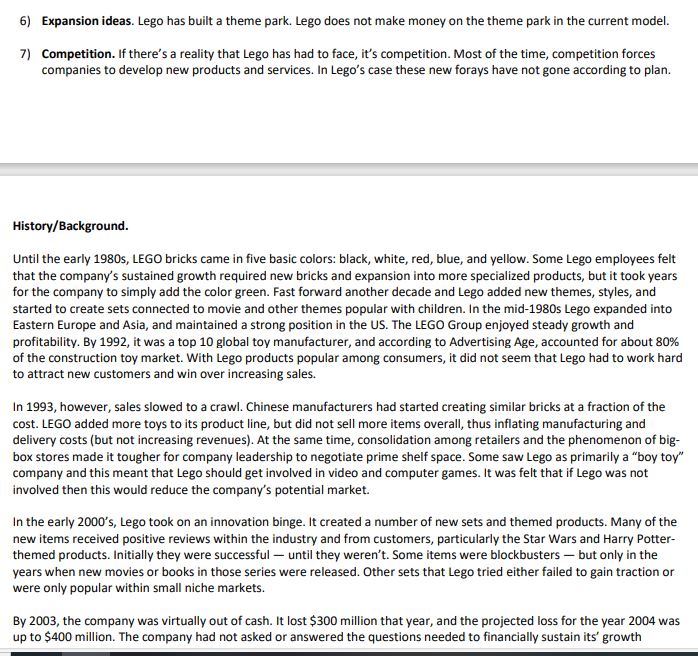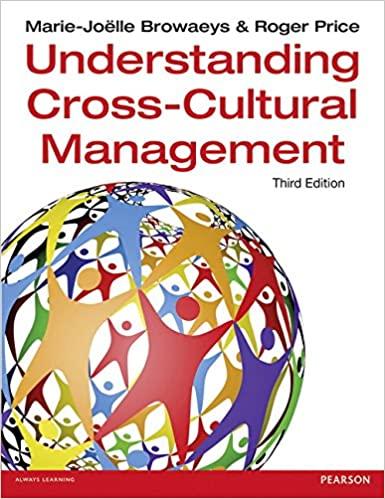Answered step by step
Verified Expert Solution
Question
1 Approved Answer
In this assignment you will: 1) Understand some of the problems that Lego is facing using the resources provided in this assignment sheet, 2)



In this assignment you will: 1) Understand some of the problems that Lego is facing using the resources provided in this assignment sheet, 2) Figure out the type, nature, and extent of the changes that you propose to make given the problems that Lego is facing, and 3) Use the worksheet provided to build out a plan for the change that you believe would fix the problems that Lego is facing. Background: Lego is a strong brand that has existed since 1932. The year is 2003. You are the CEO of Lego named Jorgen Vig Knudstorp. You were formerly a management consultant at McKinsey & Company. Lego is facing a crisis - change management is needed. This assignment requires that you analyze the situation and use the change management framework presented in class. Each page of this assignment will be the input needed for your analysis: 1) Sales are down. Lego corporate revenue and costs: Year Revenue (in $M USD) 1999 2000 2001 2002 2003 (projected) $600 $580 $550 $510 $500 Costs (in $M USD) $500 $560 $580 $630 $660 2) Currently Lego is $800M USD in debt. Projected revenue for 2004 is $350M USD and costs are projected to stay the same at $660M USD. 3) In terms of product expansion, Lego has unveiled a number of new products between 2000 and 2003. Some have been successful while others have resulted in fewer sales than expected. Currently (in 2003), Lego produces approximately 13,000 distinct pieces with several thousand different sets. 4) Organizational structure. Lego has divided its' global sales areas into 6 regions. There are 12 Vice Presidents responsible for those 6 regions as well as the direct-to-consumer sales and the global supply chain. There are problems within this structure - a lack of collaboration, confusion over roles and responsibilities, and differences in approaches between the different global regions. 5) Brand image. Lego has a strong positive brand image with a consistently high percentage of respondents believing that Lego offers good value to consumers, a positive role model to children, and that it provides wholesome products. 6) Expansion ideas. Lego has built a theme park. Lego does not make money on the theme park in the current model. 7) Competition. If there's a reality that Lego has had to face, it's competition. Most of the time, competition forces companies to develop new products and services. In Lego's case these new forays have not gone according to plan. History/Background. Until the early 1980s, LEGO bricks came in five basic colors: black, white, red, blue, and yellow. Some Lego employees felt that the company's sustained growth required new bricks and expansion into more specialized products, but it took years for the company to simply add the color green. Fast forward another decade and Lego added new themes, styles, and started to create sets connected to movie and other themes popular with children. In the mid-1980s Lego expanded into Eastern Europe and Asia, and maintained a strong position in the US. The LEGO Group enjoyed steady growth and profitability. By 1992, it was a top 10 global toy manufacturer, and according to Advertising Age, accounted for about 80% of the construction toy market. With Lego products popular among consumers, it did not seem that Lego had to work hard to attract new customers and win over increasing sales. In 1993, however, sales slowed to a crawl. Chinese manufacturers had started creating similar bricks at a fraction of the cost. LEGO added more toys to its product line, but did not sell more items overall, thus inflating manufacturing and delivery costs (but not increasing revenues). At the same time, consolidation among retailers and the phenomenon of big- box stores made it tougher for company leadership to negotiate prime shelf space. Some saw Lego as primarily a "boy toy" company and this meant that Lego should get involved in video and computer games. It was felt that if Lego was not involved then this would reduce the company's potential market. In the early 2000's, Lego took on an innovation binge. It created a number of new sets and themed products. Many of the new items received positive reviews within the industry and from customers, particularly the Star Wars and Harry Potter- themed products. Initially they were successful- until they weren't. Some items were blockbusters - but only in the years when new movies or books in those series were released. Other sets that Lego tried either failed to gain traction or were only popular within small niche markets. By 2003, the company was virtually out of cash. It lost $300 million that year, and the projected loss for the year 2004 was up to $400 million. The company had not asked or answered the questions needed to financially sustain its' growth In the early 2000's, Lego took on an innovation binge. It created a number of new sets and themed products. Many of the new items received positive reviews within the industry and from customers, particularly the Star Wars and Harry Potter- themed products. Initially they were successful- until they weren't. Some items were blockbusters - but only in the years when new movies or books in those series were released. Other sets that Lego tried either failed to gain traction or were only popular within small niche markets. By 2003, the company was virtually out of cash. It lost $300 million that year, and the projected loss for the year 2004 was up to $400 million. The company had not asked or answered the questions needed to financially sustain its' growth - questions such as, "Where do you want to go?", "Where are you now?" and "How will you get there?"
Step by Step Solution
★★★★★
3.30 Rating (159 Votes )
There are 3 Steps involved in it
Step: 1
Answer Based on the provided background information and the problems faced by LEGO here is an analysis and proposed change management plan 1 Financial Issues Declining revenue and increasing costs ove...
Get Instant Access to Expert-Tailored Solutions
See step-by-step solutions with expert insights and AI powered tools for academic success
Step: 2

Step: 3

Ace Your Homework with AI
Get the answers you need in no time with our AI-driven, step-by-step assistance
Get Started


